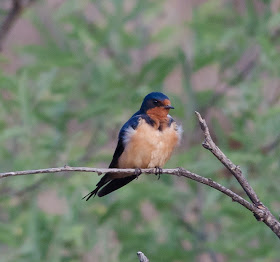Sunday dawned with cool temperatures and a lot of clouds. They clouds persisted throughout the day and at times brought intermittent rains showers. Consequently, some of the birding was slightly dampened. But it was a great day as we saw more great birds.
The day before, our visit to Woods Canyon Lake was highlighted by the Red-faced Warblers, so on this day we paid a visit to Black Canyon Lake and was treated to a different species of warbler, Grace's Warbler. Black Canyon Lake is a bit more secluded and consequently we had smaller crowds of humans. Grace's Warbler is a another warbler that breeds in the southwestern parts of the United States. Its range tends to be a bit larger than the Red-faced Warbler and it loves the pine trees as it forages for insects on the tips of branches covered with needles.
Grace's Warbler
Grace's Warbler
Grace's Warbler
A couple of other birds at the lake were the Steller's Jays and Brewer's Blackbirds. The Steller's Jays were quite numerous, but on this day, they played hard to get when it came to photos. So I just ended up with a rear end shot, but that blue color on those wings is quite vivid. The Brewer's Blackbird is quite striking with its bright eye and glossy colored plumage.
Steller's Jay
Brewer's Blackbird
To reach Black Canyon Lake, we took FR 86 from Heber and along this road are several historical points of interest and they also include several hot spots for birds. At one of those spots, we found a Broad-tailed Hummingbird that posed nicely for us. We had several males zip by us and they are easy to recognize when they do this by the trill the males make with their wings. Another bird was the Cordilleran Flycatcher; another one of those 'difficult-to-identify' Empidonax flycatchers. Much of the time, this family of birds are best identified by their call notes, but by knowing habitat preferences, ranges, and breeding behaviors, many can still be identified. Cordilleran Flycatchers choose coniferous pine forests at high elevations for breeding and are quite common in Arizona in the right habitats and in breeding season. Not an easy class of birds to learn for a novice birder, but with practice and repetitive familiarization of them, it does get easier
Broad-tailed Hummingbird
Cordilleran Flycatcher
At another stop along the road, we happened to locate the Arizona state Amphibian, the Arizona Tree Frog. I had not seen this species before and it was quite a treat. Their bright green color blends in quite nicely in the bright green grass near the stream.
Arizona Tree Frog
Our day came to a close with heavier rain showers and at one point when we arrived in Payson, it was pouring and visibility was very low. But by the time we got out of town, it had subsided quite nicely for a very enjoyable trip back to the heat of the city.




























































